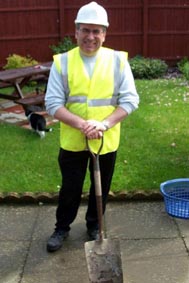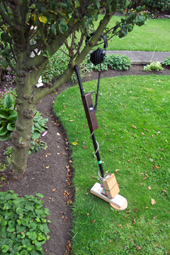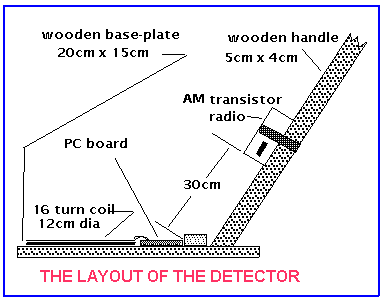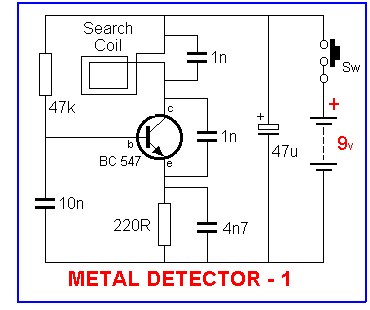
|
MY METAL DETECTOR |
Here are the details of a simple Metal detector which I made from plans I once saw in a school book.
This is a very simple detector which uses the interference from a simple transmitting circuit and coil, on a small pocket radio receiver.
When the receiver is tuned to a M.W. radio station the resulting feedback howl,caused by the transmitter can be set to alter, or appear when the coil and radio are above or near a metal object
The radio is a normal small pocket type powered by two 1.5volt batteries. The transmitter is powered by a 9v one.

Here is a picture of the finished Detector
Here is a pictured of the search head. It is made from a margarine tub.the small radio receiver is fitted inside the cover which is the wound coil on a disc.

Search head open showing the radio and coil fixed to cover
The handle from a scrapped carpet cleaner with the transmitter circuit and 9vbattery clamped
near the top. Note the ear phones plugged in the side, the cables all run down inside the handle tube.
This is the schematic for the transmitter circuit which is housed in the box near the handle. The coil L1 is actually in the search head. the wires for this and the ear phones run down the handle hollow tube.
I originally made this detector for the fun of doing the electronics and had no experience in the treasure seeking aspect of metal detectors. My son Bobby has this experience, so I decided to accompany him on a treasure hunt.
We spent a whole Sunday afternoon searching a field which had been earmarked for house building and was lying redundant. My son was in charge of the spade work which pleased me, as this can be quite hard work on uncultivated ground. I operated the detector and found this, like fishing, completely addictive, with the well known," just another five minutes" syndrome . The fading daylight finally finished the search for the day.
The field lay alongside the railway lines and we started at the gate and walked along parallel with the lines , immediately the machine started to signal and did so every few minutes. after turning up many bolts nuts nails and scrap metal we came to the conclusion this was the area the railway workmen had used, and moved into the middle of the field.
We now started to find more interesting items The first was a pocket knife in nice condition, I was intrigued by the stain at the tip of the blade It could have been blood or maybe tobacco. Later a brass button slightly bashed but still with traces of a coloured design on it.
I think what makes this metal detecting so interesting is, you start to wonder where the item came from how it got there
to whom did it belong .
This was my first taste of treasure seeking ,and it proved to be very interesting and I can understand how it is so popular with so many people.My son is very accomplished detector and has found some very valuable objects.
I wish him luck and hope he finds a pot of gold one day.

My son Bobby who is an official member of East Lothian archeology team.
Below a groat which he unearthed near Kelso,
Found at Kelso September 2003 in a stubble field at a depth of only 3” after joining a club and being a member for 4 months
Given to Museum who already had one in their collection so returned to me
You can go here for details of David 2 nd coin he found
http://www.nwlink.com/~scotlass/newpage2.htm
Or here http://www.predecimal.com/p12scottish.htm
METAL DETECTOR Mrk 2
This is another detector which I have just completed in an effort to increase the search qualities. ie more depth.
below are the pictures and details.




![]()
These two sketches provide all the information required to build the detector click the hyperlink for the source of
the project
http://www.talkingelectronics.com/te_interactive_index.html
In the list on the left click on METAL DETECTOR
| © John K Wilson |